Essay: Traditional/Alternative Medicine in the Healthcare System
VerifiedAdded on 2020/04/07
|11
|3207
|183
Essay
AI Summary
This essay provides a comprehensive overview of traditional and alternative medicine (CAM) within the current healthcare system, primarily focusing on its applications, advantages, and limitations. The essay explores the increasing popularity of CAM, highlighting its holistic approach, personalized attention, and focus on disease prevention. It discusses the use of CAM in treating various conditions, including mental health disorders like PTSD and mood disorders, as well as life-threatening diseases such as cancer and inflammatory bowel disease (IBD). Through a literature search, the essay presents both the benefits of CAM, such as pain management and reduced side effects from conventional treatments, and the challenges it faces, including a scarcity of evidence-based practice, lack of standardized ingredients, and potential dangerous interactions. The essay concludes by emphasizing the importance of patient-centered care and the need for further research to facilitate the integration of CAM into the healthcare system. The essay includes analysis from various peer-reviewed articles, cross-sectional studies, interviews, and questionnaires, providing a balanced perspective on the role of CAM in modern medicine. It acknowledges the potential for CAM to improve patient outcomes while also addressing the need for rigorous scientific validation and standardization.
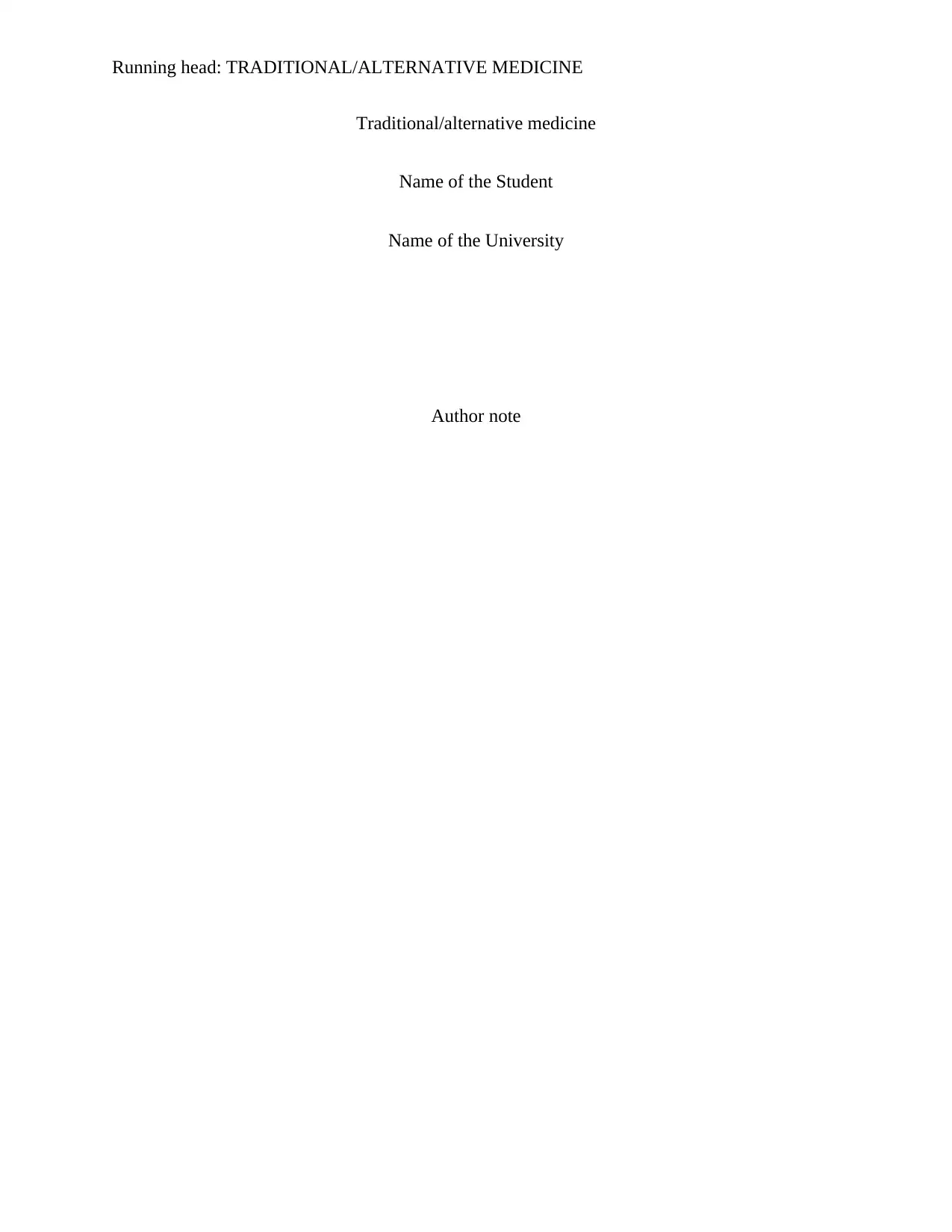
Running head: TRADITIONAL/ALTERNATIVE MEDICINE
Traditional/alternative medicine
Name of the Student
Name of the University
Author note
Traditional/alternative medicine
Name of the Student
Name of the University
Author note
Paraphrase This Document
Need a fresh take? Get an instant paraphrase of this document with our AI Paraphraser
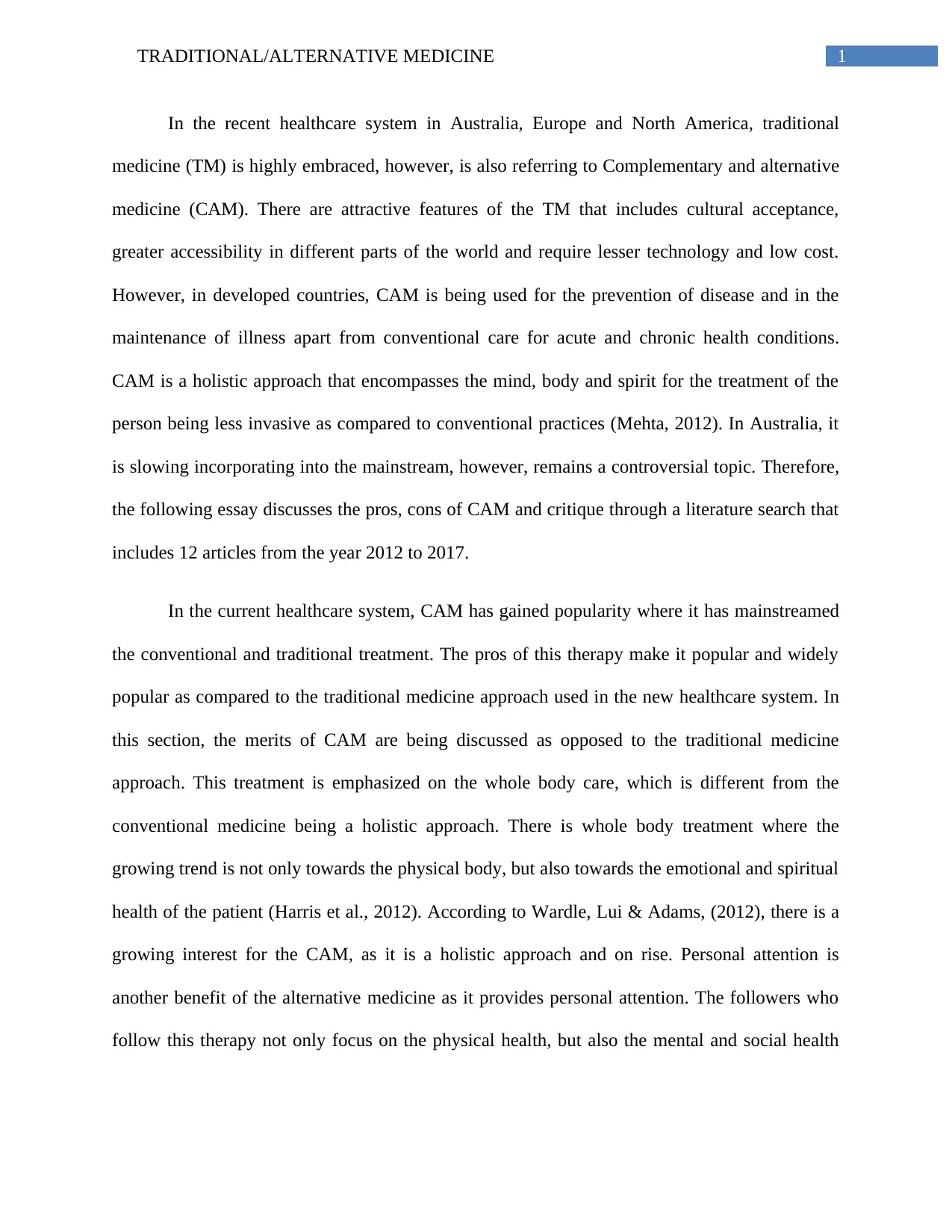
1TRADITIONAL/ALTERNATIVE MEDICINE
In the recent healthcare system in Australia, Europe and North America, traditional
medicine (TM) is highly embraced, however, is also referring to Complementary and alternative
medicine (CAM). There are attractive features of the TM that includes cultural acceptance,
greater accessibility in different parts of the world and require lesser technology and low cost.
However, in developed countries, CAM is being used for the prevention of disease and in the
maintenance of illness apart from conventional care for acute and chronic health conditions.
CAM is a holistic approach that encompasses the mind, body and spirit for the treatment of the
person being less invasive as compared to conventional practices (Mehta, 2012). In Australia, it
is slowing incorporating into the mainstream, however, remains a controversial topic. Therefore,
the following essay discusses the pros, cons of CAM and critique through a literature search that
includes 12 articles from the year 2012 to 2017.
In the current healthcare system, CAM has gained popularity where it has mainstreamed
the conventional and traditional treatment. The pros of this therapy make it popular and widely
popular as compared to the traditional medicine approach used in the new healthcare system. In
this section, the merits of CAM are being discussed as opposed to the traditional medicine
approach. This treatment is emphasized on the whole body care, which is different from the
conventional medicine being a holistic approach. There is whole body treatment where the
growing trend is not only towards the physical body, but also towards the emotional and spiritual
health of the patient (Harris et al., 2012). According to Wardle, Lui & Adams, (2012), there is a
growing interest for the CAM, as it is a holistic approach and on rise. Personal attention is
another benefit of the alternative medicine as it provides personal attention. The followers who
follow this therapy not only focus on the physical health, but also the mental and social health
In the recent healthcare system in Australia, Europe and North America, traditional
medicine (TM) is highly embraced, however, is also referring to Complementary and alternative
medicine (CAM). There are attractive features of the TM that includes cultural acceptance,
greater accessibility in different parts of the world and require lesser technology and low cost.
However, in developed countries, CAM is being used for the prevention of disease and in the
maintenance of illness apart from conventional care for acute and chronic health conditions.
CAM is a holistic approach that encompasses the mind, body and spirit for the treatment of the
person being less invasive as compared to conventional practices (Mehta, 2012). In Australia, it
is slowing incorporating into the mainstream, however, remains a controversial topic. Therefore,
the following essay discusses the pros, cons of CAM and critique through a literature search that
includes 12 articles from the year 2012 to 2017.
In the current healthcare system, CAM has gained popularity where it has mainstreamed
the conventional and traditional treatment. The pros of this therapy make it popular and widely
popular as compared to the traditional medicine approach used in the new healthcare system. In
this section, the merits of CAM are being discussed as opposed to the traditional medicine
approach. This treatment is emphasized on the whole body care, which is different from the
conventional medicine being a holistic approach. There is whole body treatment where the
growing trend is not only towards the physical body, but also towards the emotional and spiritual
health of the patient (Harris et al., 2012). According to Wardle, Lui & Adams, (2012), there is a
growing interest for the CAM, as it is a holistic approach and on rise. Personal attention is
another benefit of the alternative medicine as it provides personal attention. The followers who
follow this therapy not only focus on the physical health, but also the mental and social health

2TRADITIONAL/ALTERNATIVE MEDICINE
aspects of the illness affecting an individual. This factor provides healthier focus on the causes of
the ailments rather that result in the imbalances in the body originally (Wu et al., 2014).
CAM has one more advantage that it focuses on the prevention. The traditional medicine
provides intervention after the disease onset; however, alternative medicine focus on prevention
of the disease before it occurs in addition to the care delivery (Hawk, Ndetan & Evans, 2012).
After the literature search, I found that there are wide applications of CAM for the treatment of
diseases ranging from mental health problems like mood disorders to fatal diseases like cancer.
According to Libby, Pilver & Desai, (2013) the study conducted described the use of CAM in the
treatment of emotional and mental problems in Posttraumatic Stress Disorder (PTSD)
individuals. Data was collected from the 599 individuals with PSTD and descriptive analyses
showed 15 cases where CAM was used for treatment. CAM was used as an alternative to the
conventional medicine in the mental health care. In another systematic content analysis,
according to Shim, (2015) there are two CAM interventions herbal medicine and acupuncture
that are popular in U.S. and Japan. The results showed that herbal medicine is integrated into the
mainstream medical system in Japan and least in America. Acupuncture is less commonly
practiced in America, Japan, and herbal medicine being most favorable in Japan and least in
America. According to Thomson et al., (2012) CAM is widespread and highly prevalent in
Australia among the adult population. The results of the cross-sectional study showed that CAM
is highly popular in Australia, however, people does not seek advice from their physicians before
and after using CAM that require further consideration.
According to Kang et al., (2012) there is increase in CAM use among breast cancer
patients in Korea. Around 57.4% of patients were reported to use this therapy that included
exercise therapy and consumption of vitamins and minerals that boosted their immune system,
aspects of the illness affecting an individual. This factor provides healthier focus on the causes of
the ailments rather that result in the imbalances in the body originally (Wu et al., 2014).
CAM has one more advantage that it focuses on the prevention. The traditional medicine
provides intervention after the disease onset; however, alternative medicine focus on prevention
of the disease before it occurs in addition to the care delivery (Hawk, Ndetan & Evans, 2012).
After the literature search, I found that there are wide applications of CAM for the treatment of
diseases ranging from mental health problems like mood disorders to fatal diseases like cancer.
According to Libby, Pilver & Desai, (2013) the study conducted described the use of CAM in the
treatment of emotional and mental problems in Posttraumatic Stress Disorder (PTSD)
individuals. Data was collected from the 599 individuals with PSTD and descriptive analyses
showed 15 cases where CAM was used for treatment. CAM was used as an alternative to the
conventional medicine in the mental health care. In another systematic content analysis,
according to Shim, (2015) there are two CAM interventions herbal medicine and acupuncture
that are popular in U.S. and Japan. The results showed that herbal medicine is integrated into the
mainstream medical system in Japan and least in America. Acupuncture is less commonly
practiced in America, Japan, and herbal medicine being most favorable in Japan and least in
America. According to Thomson et al., (2012) CAM is widespread and highly prevalent in
Australia among the adult population. The results of the cross-sectional study showed that CAM
is highly popular in Australia, however, people does not seek advice from their physicians before
and after using CAM that require further consideration.
According to Kang et al., (2012) there is increase in CAM use among breast cancer
patients in Korea. Around 57.4% of patients were reported to use this therapy that included
exercise therapy and consumption of vitamins and minerals that boosted their immune system,
⊘ This is a preview!⊘
Do you want full access?
Subscribe today to unlock all pages.

Trusted by 1+ million students worldwide

3TRADITIONAL/ALTERNATIVE MEDICINE
promoted health and prevented recurrence. In another study through structured interviews, it
showed that they used CAM among cancer patients as it helped them for sustenance of strength
and gained ability to perform activities. In a cross-sectional, study through interview-
administered questionnaire conducted by Jazieh et al., (2012) the results showed that
complementary therapies are highly prevalent in Saudi Arabia with interventions that indicate
religious background and strong cultural beliefs when people are suffering from life-threatening
diseases. CAM is also used in inflammatory bowel disease (IBD) among the patients who
experienced adverse side effects of conventional medications. Alternative medicine is also used
in residential palliative care among German patients with advanced cancer in the form of prayer
and supplements as studied by Paul et al., (2013). Similar study conducted by Weizman et al.,
(2012) also showed that CAM is prevalent among the IBD patients and helps to reduce the
adverse effects of the conventional medicines. The above primary studies conducted on CAM in
different countries for life-threatening diseases depicts that CAM is a holistic approach and
achievable option to cure problems and its integration in the current healthcare system.
Although, CAM is gaining popularity in the current healthcare system, there are
challenges faced that acts as obstacles in the path of its integration into the country’s medical and
healthcare system. This is scarcity of evidence based practice and lack of research regarding the
CAM that are scientifically documented with rigid clinical trials. Although, CAM are beneficial,
there is lack of clinical trials with unknown long and short term risks associated with its
administration. There is also lack of evidence-based practice to confirm that CAM administration
guidelines comply with the Australian standards and have the potential to integrate into the
current healthcare system (Reddy, Grossman & Rogers, 2013). There is limited scientific
research regarding CAM as compared to traditional medical treatment where the evidence is
promoted health and prevented recurrence. In another study through structured interviews, it
showed that they used CAM among cancer patients as it helped them for sustenance of strength
and gained ability to perform activities. In a cross-sectional, study through interview-
administered questionnaire conducted by Jazieh et al., (2012) the results showed that
complementary therapies are highly prevalent in Saudi Arabia with interventions that indicate
religious background and strong cultural beliefs when people are suffering from life-threatening
diseases. CAM is also used in inflammatory bowel disease (IBD) among the patients who
experienced adverse side effects of conventional medications. Alternative medicine is also used
in residential palliative care among German patients with advanced cancer in the form of prayer
and supplements as studied by Paul et al., (2013). Similar study conducted by Weizman et al.,
(2012) also showed that CAM is prevalent among the IBD patients and helps to reduce the
adverse effects of the conventional medicines. The above primary studies conducted on CAM in
different countries for life-threatening diseases depicts that CAM is a holistic approach and
achievable option to cure problems and its integration in the current healthcare system.
Although, CAM is gaining popularity in the current healthcare system, there are
challenges faced that acts as obstacles in the path of its integration into the country’s medical and
healthcare system. This is scarcity of evidence based practice and lack of research regarding the
CAM that are scientifically documented with rigid clinical trials. Although, CAM are beneficial,
there is lack of clinical trials with unknown long and short term risks associated with its
administration. There is also lack of evidence-based practice to confirm that CAM administration
guidelines comply with the Australian standards and have the potential to integrate into the
current healthcare system (Reddy, Grossman & Rogers, 2013). There is limited scientific
research regarding CAM as compared to traditional medical treatment where the evidence is
Paraphrase This Document
Need a fresh take? Get an instant paraphrase of this document with our AI Paraphraser
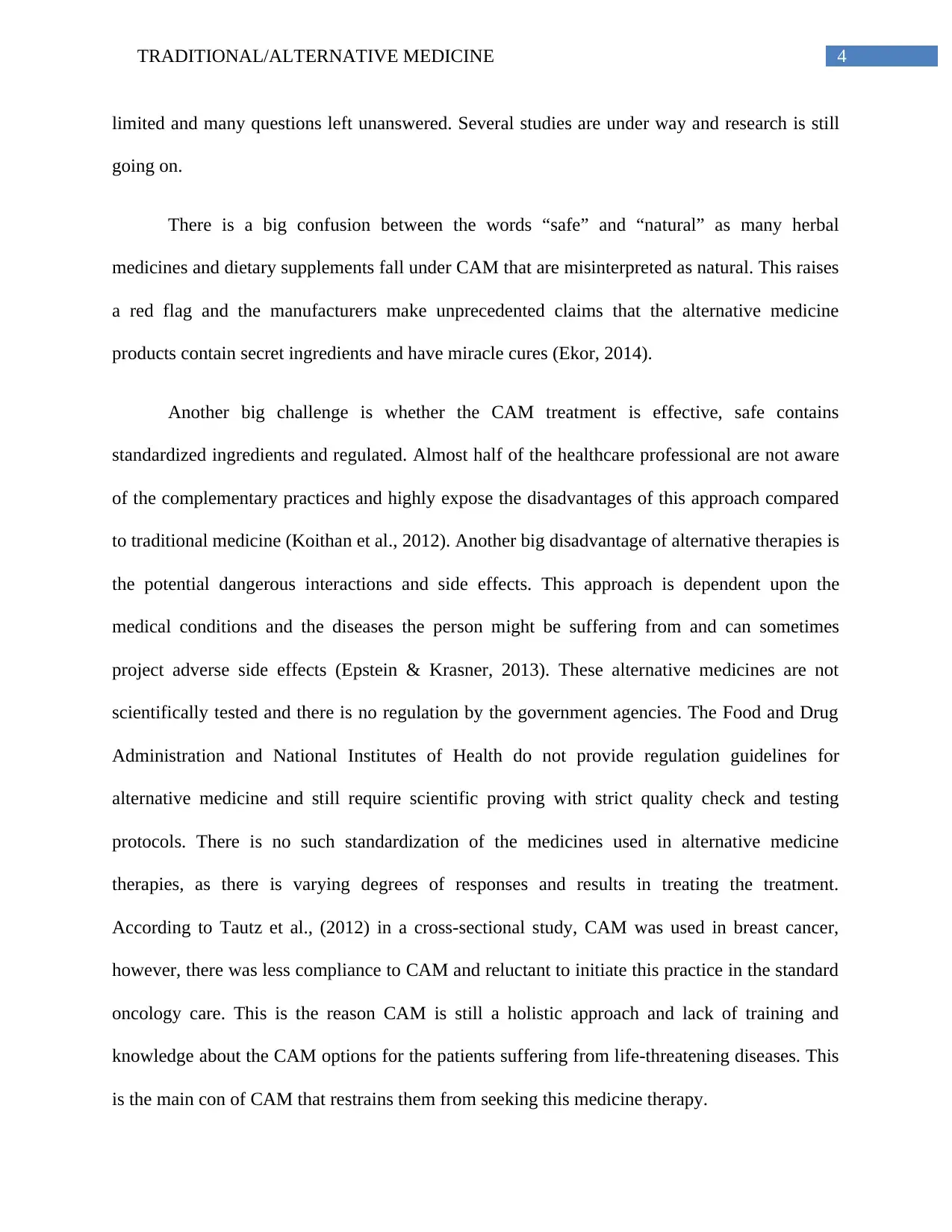
4TRADITIONAL/ALTERNATIVE MEDICINE
limited and many questions left unanswered. Several studies are under way and research is still
going on.
There is a big confusion between the words “safe” and “natural” as many herbal
medicines and dietary supplements fall under CAM that are misinterpreted as natural. This raises
a red flag and the manufacturers make unprecedented claims that the alternative medicine
products contain secret ingredients and have miracle cures (Ekor, 2014).
Another big challenge is whether the CAM treatment is effective, safe contains
standardized ingredients and regulated. Almost half of the healthcare professional are not aware
of the complementary practices and highly expose the disadvantages of this approach compared
to traditional medicine (Koithan et al., 2012). Another big disadvantage of alternative therapies is
the potential dangerous interactions and side effects. This approach is dependent upon the
medical conditions and the diseases the person might be suffering from and can sometimes
project adverse side effects (Epstein & Krasner, 2013). These alternative medicines are not
scientifically tested and there is no regulation by the government agencies. The Food and Drug
Administration and National Institutes of Health do not provide regulation guidelines for
alternative medicine and still require scientific proving with strict quality check and testing
protocols. There is no such standardization of the medicines used in alternative medicine
therapies, as there is varying degrees of responses and results in treating the treatment.
According to Tautz et al., (2012) in a cross-sectional study, CAM was used in breast cancer,
however, there was less compliance to CAM and reluctant to initiate this practice in the standard
oncology care. This is the reason CAM is still a holistic approach and lack of training and
knowledge about the CAM options for the patients suffering from life-threatening diseases. This
is the main con of CAM that restrains them from seeking this medicine therapy.
limited and many questions left unanswered. Several studies are under way and research is still
going on.
There is a big confusion between the words “safe” and “natural” as many herbal
medicines and dietary supplements fall under CAM that are misinterpreted as natural. This raises
a red flag and the manufacturers make unprecedented claims that the alternative medicine
products contain secret ingredients and have miracle cures (Ekor, 2014).
Another big challenge is whether the CAM treatment is effective, safe contains
standardized ingredients and regulated. Almost half of the healthcare professional are not aware
of the complementary practices and highly expose the disadvantages of this approach compared
to traditional medicine (Koithan et al., 2012). Another big disadvantage of alternative therapies is
the potential dangerous interactions and side effects. This approach is dependent upon the
medical conditions and the diseases the person might be suffering from and can sometimes
project adverse side effects (Epstein & Krasner, 2013). These alternative medicines are not
scientifically tested and there is no regulation by the government agencies. The Food and Drug
Administration and National Institutes of Health do not provide regulation guidelines for
alternative medicine and still require scientific proving with strict quality check and testing
protocols. There is no such standardization of the medicines used in alternative medicine
therapies, as there is varying degrees of responses and results in treating the treatment.
According to Tautz et al., (2012) in a cross-sectional study, CAM was used in breast cancer,
however, there was less compliance to CAM and reluctant to initiate this practice in the standard
oncology care. This is the reason CAM is still a holistic approach and lack of training and
knowledge about the CAM options for the patients suffering from life-threatening diseases. This
is the main con of CAM that restrains them from seeking this medicine therapy.
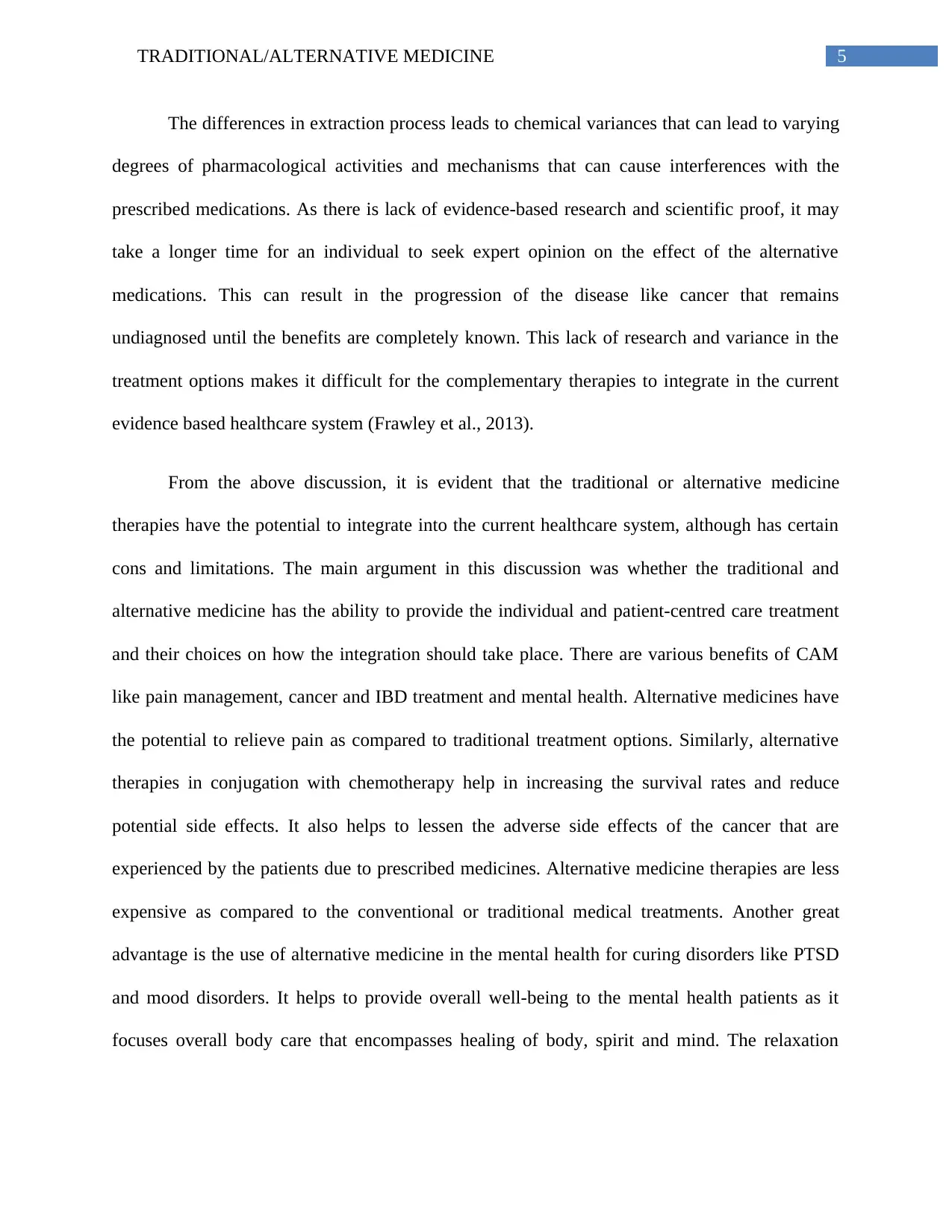
5TRADITIONAL/ALTERNATIVE MEDICINE
The differences in extraction process leads to chemical variances that can lead to varying
degrees of pharmacological activities and mechanisms that can cause interferences with the
prescribed medications. As there is lack of evidence-based research and scientific proof, it may
take a longer time for an individual to seek expert opinion on the effect of the alternative
medications. This can result in the progression of the disease like cancer that remains
undiagnosed until the benefits are completely known. This lack of research and variance in the
treatment options makes it difficult for the complementary therapies to integrate in the current
evidence based healthcare system (Frawley et al., 2013).
From the above discussion, it is evident that the traditional or alternative medicine
therapies have the potential to integrate into the current healthcare system, although has certain
cons and limitations. The main argument in this discussion was whether the traditional and
alternative medicine has the ability to provide the individual and patient-centred care treatment
and their choices on how the integration should take place. There are various benefits of CAM
like pain management, cancer and IBD treatment and mental health. Alternative medicines have
the potential to relieve pain as compared to traditional treatment options. Similarly, alternative
therapies in conjugation with chemotherapy help in increasing the survival rates and reduce
potential side effects. It also helps to lessen the adverse side effects of the cancer that are
experienced by the patients due to prescribed medicines. Alternative medicine therapies are less
expensive as compared to the conventional or traditional medical treatments. Another great
advantage is the use of alternative medicine in the mental health for curing disorders like PTSD
and mood disorders. It helps to provide overall well-being to the mental health patients as it
focuses overall body care that encompasses healing of body, spirit and mind. The relaxation
The differences in extraction process leads to chemical variances that can lead to varying
degrees of pharmacological activities and mechanisms that can cause interferences with the
prescribed medications. As there is lack of evidence-based research and scientific proof, it may
take a longer time for an individual to seek expert opinion on the effect of the alternative
medications. This can result in the progression of the disease like cancer that remains
undiagnosed until the benefits are completely known. This lack of research and variance in the
treatment options makes it difficult for the complementary therapies to integrate in the current
evidence based healthcare system (Frawley et al., 2013).
From the above discussion, it is evident that the traditional or alternative medicine
therapies have the potential to integrate into the current healthcare system, although has certain
cons and limitations. The main argument in this discussion was whether the traditional and
alternative medicine has the ability to provide the individual and patient-centred care treatment
and their choices on how the integration should take place. There are various benefits of CAM
like pain management, cancer and IBD treatment and mental health. Alternative medicines have
the potential to relieve pain as compared to traditional treatment options. Similarly, alternative
therapies in conjugation with chemotherapy help in increasing the survival rates and reduce
potential side effects. It also helps to lessen the adverse side effects of the cancer that are
experienced by the patients due to prescribed medicines. Alternative medicine therapies are less
expensive as compared to the conventional or traditional medical treatments. Another great
advantage is the use of alternative medicine in the mental health for curing disorders like PTSD
and mood disorders. It helps to provide overall well-being to the mental health patients as it
focuses overall body care that encompasses healing of body, spirit and mind. The relaxation
⊘ This is a preview!⊘
Do you want full access?
Subscribe today to unlock all pages.

Trusted by 1+ million students worldwide
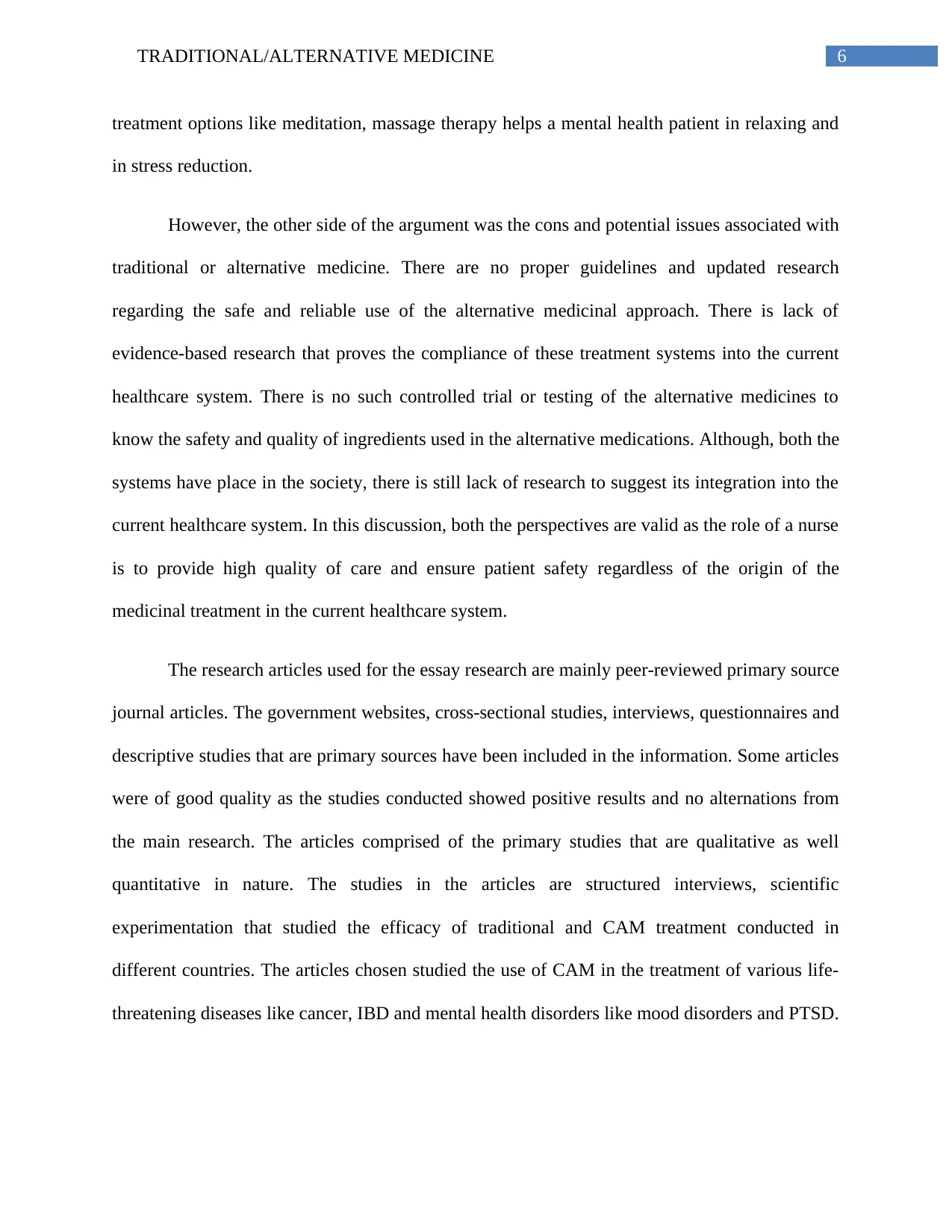
6TRADITIONAL/ALTERNATIVE MEDICINE
treatment options like meditation, massage therapy helps a mental health patient in relaxing and
in stress reduction.
However, the other side of the argument was the cons and potential issues associated with
traditional or alternative medicine. There are no proper guidelines and updated research
regarding the safe and reliable use of the alternative medicinal approach. There is lack of
evidence-based research that proves the compliance of these treatment systems into the current
healthcare system. There is no such controlled trial or testing of the alternative medicines to
know the safety and quality of ingredients used in the alternative medications. Although, both the
systems have place in the society, there is still lack of research to suggest its integration into the
current healthcare system. In this discussion, both the perspectives are valid as the role of a nurse
is to provide high quality of care and ensure patient safety regardless of the origin of the
medicinal treatment in the current healthcare system.
The research articles used for the essay research are mainly peer-reviewed primary source
journal articles. The government websites, cross-sectional studies, interviews, questionnaires and
descriptive studies that are primary sources have been included in the information. Some articles
were of good quality as the studies conducted showed positive results and no alternations from
the main research. The articles comprised of the primary studies that are qualitative as well
quantitative in nature. The studies in the articles are structured interviews, scientific
experimentation that studied the efficacy of traditional and CAM treatment conducted in
different countries. The articles chosen studied the use of CAM in the treatment of various life-
threatening diseases like cancer, IBD and mental health disorders like mood disorders and PTSD.
treatment options like meditation, massage therapy helps a mental health patient in relaxing and
in stress reduction.
However, the other side of the argument was the cons and potential issues associated with
traditional or alternative medicine. There are no proper guidelines and updated research
regarding the safe and reliable use of the alternative medicinal approach. There is lack of
evidence-based research that proves the compliance of these treatment systems into the current
healthcare system. There is no such controlled trial or testing of the alternative medicines to
know the safety and quality of ingredients used in the alternative medications. Although, both the
systems have place in the society, there is still lack of research to suggest its integration into the
current healthcare system. In this discussion, both the perspectives are valid as the role of a nurse
is to provide high quality of care and ensure patient safety regardless of the origin of the
medicinal treatment in the current healthcare system.
The research articles used for the essay research are mainly peer-reviewed primary source
journal articles. The government websites, cross-sectional studies, interviews, questionnaires and
descriptive studies that are primary sources have been included in the information. Some articles
were of good quality as the studies conducted showed positive results and no alternations from
the main research. The articles comprised of the primary studies that are qualitative as well
quantitative in nature. The studies in the articles are structured interviews, scientific
experimentation that studied the efficacy of traditional and CAM treatment conducted in
different countries. The articles chosen studied the use of CAM in the treatment of various life-
threatening diseases like cancer, IBD and mental health disorders like mood disorders and PTSD.
Paraphrase This Document
Need a fresh take? Get an instant paraphrase of this document with our AI Paraphraser

7TRADITIONAL/ALTERNATIVE MEDICINE
Some articles used had descriptive studies conducted in the form of structured interviews
and questionnaires on the various observational outcomes of the CAM on life threatening
diseases. In those articles, the effectiveness of CAM is not studied properly as the results
deviated from the main research. Out of 20 articles, 12 articles were considered eligible for the
research retrieved from Cochrane, Medline and Ovid. The articles were mainly cross-sectional
studies conducted in the form of interviews and questionnaires given to the participants. This
might be a drawback in the research study as the structured interviews contain closed-ended
questions. The perceptions and perspective of the patients regarding the use of CAM might
require open-ended questions, as they are descriptive. This is the reason the articles were
carefully selected that is current and is not older than 7 years from 2012 to 2017. The articles are
published in renowned journals retrieved from authentic databases that make it globally accepted
and provide credible information for the research.
Some articles used had descriptive studies conducted in the form of structured interviews
and questionnaires on the various observational outcomes of the CAM on life threatening
diseases. In those articles, the effectiveness of CAM is not studied properly as the results
deviated from the main research. Out of 20 articles, 12 articles were considered eligible for the
research retrieved from Cochrane, Medline and Ovid. The articles were mainly cross-sectional
studies conducted in the form of interviews and questionnaires given to the participants. This
might be a drawback in the research study as the structured interviews contain closed-ended
questions. The perceptions and perspective of the patients regarding the use of CAM might
require open-ended questions, as they are descriptive. This is the reason the articles were
carefully selected that is current and is not older than 7 years from 2012 to 2017. The articles are
published in renowned journals retrieved from authentic databases that make it globally accepted
and provide credible information for the research.

8TRADITIONAL/ALTERNATIVE MEDICINE
References
Ekor, M. (2014). The growing use of herbal medicines: issues relating to adverse reactions and
challenges in monitoring safety. Frontiers in pharmacology, 4, 177.
Epstein, R. M., & Krasner, M. S. (2013). Physician resilience: what it means, why it matters, and
how to promote it. Academic Medicine, 88(3), 301-303.
Frawley, J., Adams, J., Sibbritt, D., Steel, A., Broom, A., & Gallois, C. (2013). Prevalence and
determinants of complementary and alternative medicine use during pregnancy: results
from a nationally representative sample of Australian pregnant women. Australian and
New Zealand Journal of Obstetrics and Gynaecology, 53(4), 347-352.
Harris, P. E., Cooper, K. L., Relton, C., & Thomas, K. J. (2012). Prevalence of complementary
and alternative medicine (CAM) use by the general population: a systematic review and
update. International journal of clinical practice, 66(10), 924-939.
Hawk, C., Ndetan, H., & Evans, M. W. (2012). Potential role of complementary and alternative
health care providers in chronic disease prevention and health promotion: an analysis of
National Health Interview Survey data. Preventive medicine, 54(1), 18-22.
Jazieh, A. R., Al Sudairy, R., Abulkhair, O., Alaskar, A., Al Safi, F., Sheblaq, N., ... & Tamim,
H. (2012). Use of complementary and alternative medicine by patients with cancer in
Saudi Arabia. The Journal of Alternative and Complementary Medicine, 18(11), 1045-
1049.
References
Ekor, M. (2014). The growing use of herbal medicines: issues relating to adverse reactions and
challenges in monitoring safety. Frontiers in pharmacology, 4, 177.
Epstein, R. M., & Krasner, M. S. (2013). Physician resilience: what it means, why it matters, and
how to promote it. Academic Medicine, 88(3), 301-303.
Frawley, J., Adams, J., Sibbritt, D., Steel, A., Broom, A., & Gallois, C. (2013). Prevalence and
determinants of complementary and alternative medicine use during pregnancy: results
from a nationally representative sample of Australian pregnant women. Australian and
New Zealand Journal of Obstetrics and Gynaecology, 53(4), 347-352.
Harris, P. E., Cooper, K. L., Relton, C., & Thomas, K. J. (2012). Prevalence of complementary
and alternative medicine (CAM) use by the general population: a systematic review and
update. International journal of clinical practice, 66(10), 924-939.
Hawk, C., Ndetan, H., & Evans, M. W. (2012). Potential role of complementary and alternative
health care providers in chronic disease prevention and health promotion: an analysis of
National Health Interview Survey data. Preventive medicine, 54(1), 18-22.
Jazieh, A. R., Al Sudairy, R., Abulkhair, O., Alaskar, A., Al Safi, F., Sheblaq, N., ... & Tamim,
H. (2012). Use of complementary and alternative medicine by patients with cancer in
Saudi Arabia. The Journal of Alternative and Complementary Medicine, 18(11), 1045-
1049.
⊘ This is a preview!⊘
Do you want full access?
Subscribe today to unlock all pages.

Trusted by 1+ million students worldwide

9TRADITIONAL/ALTERNATIVE MEDICINE
Kang, E., Yang, E. J., Kim, S. M., Chung, I. Y., Han, S. A., Ku, D. H., ... & Kim, S. W. (2012).
Complementary and alternative medicine use and assessment of quality of life in Korean
breast cancer patients: a descriptive study. Supportive Care in Cancer, 20(3), 461-473.
Koithan, M., Bell, I. R., Niemeyer, K., & Pincus, D. (2012). A complex systems science
perspective for whole systems of complementary and alternative medicine
research. Complementary Medicine Research, 19(Suppl. 1), 7-14.
Libby, D. J., Pilver, C. E., & Desai, R. (2013). Complementary and alternative medicine use
among individuals with posttraumatic stress disorder. Psychological Trauma: Theory,
Research, Practice, and Policy, 5(3), 277.
Mehta, D. (2012). Complementary and alternative medicine. In Physicians’ Pathways to Non-
Traditional Careers and Leadership Opportunities (pp. 309-314). Springer New York.
Paul, M., Davey, B., Senf, B., Stoll, C., Muenstedt, K., Muecke, R., ... & Hübner, J. (2013).
Patients with advanced cancer and their usage of complementary and alternative
medicine. Journal of cancer research and clinical oncology, 139(9), 1515-1522.
Reddy, K. K., Grossman, L., & Rogers, G. S. (2013). Common complementary and alternative
therapies with potential use in dermatologic surgery: risks and benefits. Journal of the
American Academy of Dermatology, 68(4), e127-e135.
Shim, J. M. (2015). The influence of social context on the treatment outcomes of complementary
and alternative medicine: the case of acupuncture and herbal medicine in Japan and the
US. Globalization and health, 11(1), 17.
Kang, E., Yang, E. J., Kim, S. M., Chung, I. Y., Han, S. A., Ku, D. H., ... & Kim, S. W. (2012).
Complementary and alternative medicine use and assessment of quality of life in Korean
breast cancer patients: a descriptive study. Supportive Care in Cancer, 20(3), 461-473.
Koithan, M., Bell, I. R., Niemeyer, K., & Pincus, D. (2012). A complex systems science
perspective for whole systems of complementary and alternative medicine
research. Complementary Medicine Research, 19(Suppl. 1), 7-14.
Libby, D. J., Pilver, C. E., & Desai, R. (2013). Complementary and alternative medicine use
among individuals with posttraumatic stress disorder. Psychological Trauma: Theory,
Research, Practice, and Policy, 5(3), 277.
Mehta, D. (2012). Complementary and alternative medicine. In Physicians’ Pathways to Non-
Traditional Careers and Leadership Opportunities (pp. 309-314). Springer New York.
Paul, M., Davey, B., Senf, B., Stoll, C., Muenstedt, K., Muecke, R., ... & Hübner, J. (2013).
Patients with advanced cancer and their usage of complementary and alternative
medicine. Journal of cancer research and clinical oncology, 139(9), 1515-1522.
Reddy, K. K., Grossman, L., & Rogers, G. S. (2013). Common complementary and alternative
therapies with potential use in dermatologic surgery: risks and benefits. Journal of the
American Academy of Dermatology, 68(4), e127-e135.
Shim, J. M. (2015). The influence of social context on the treatment outcomes of complementary
and alternative medicine: the case of acupuncture and herbal medicine in Japan and the
US. Globalization and health, 11(1), 17.
Paraphrase This Document
Need a fresh take? Get an instant paraphrase of this document with our AI Paraphraser
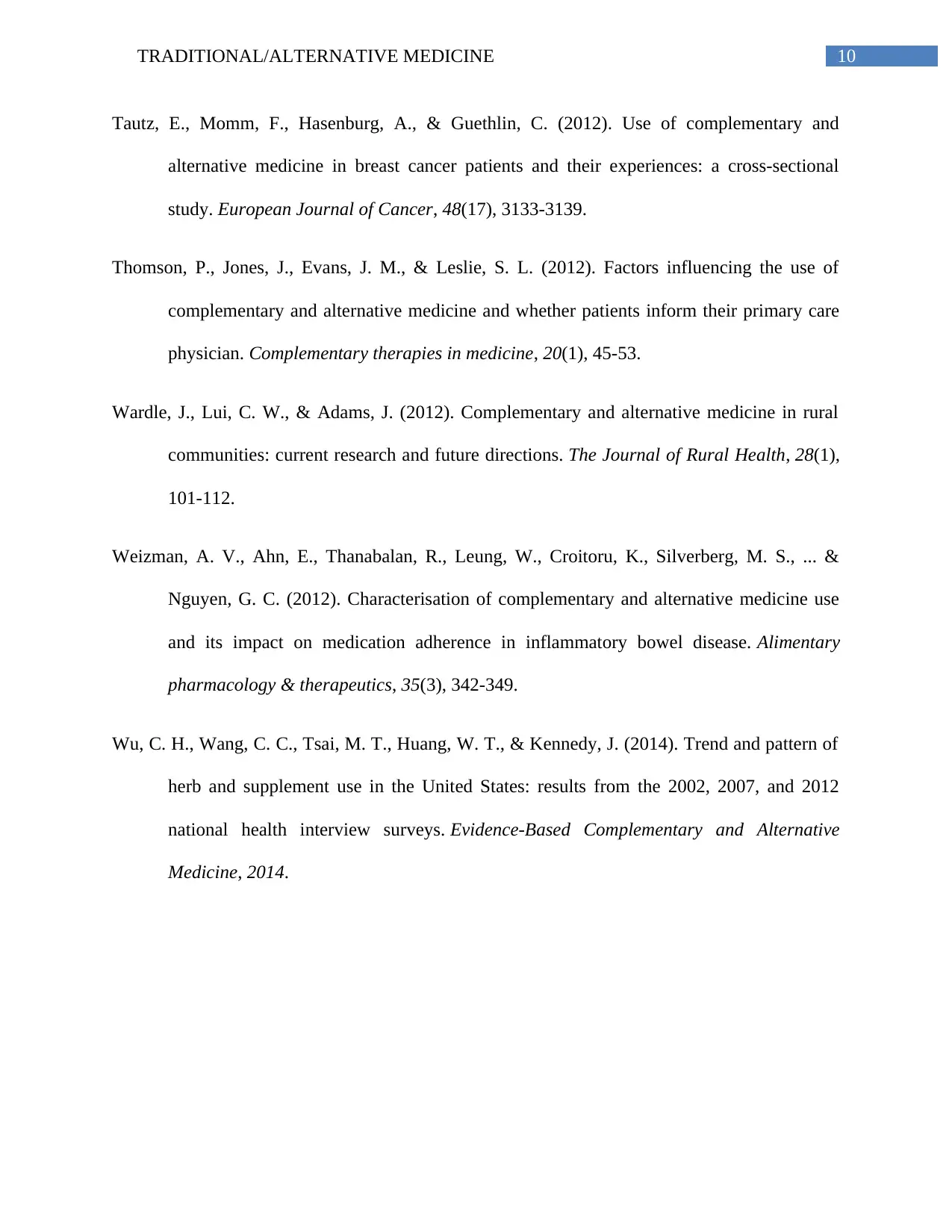
10TRADITIONAL/ALTERNATIVE MEDICINE
Tautz, E., Momm, F., Hasenburg, A., & Guethlin, C. (2012). Use of complementary and
alternative medicine in breast cancer patients and their experiences: a cross-sectional
study. European Journal of Cancer, 48(17), 3133-3139.
Thomson, P., Jones, J., Evans, J. M., & Leslie, S. L. (2012). Factors influencing the use of
complementary and alternative medicine and whether patients inform their primary care
physician. Complementary therapies in medicine, 20(1), 45-53.
Wardle, J., Lui, C. W., & Adams, J. (2012). Complementary and alternative medicine in rural
communities: current research and future directions. The Journal of Rural Health, 28(1),
101-112.
Weizman, A. V., Ahn, E., Thanabalan, R., Leung, W., Croitoru, K., Silverberg, M. S., ... &
Nguyen, G. C. (2012). Characterisation of complementary and alternative medicine use
and its impact on medication adherence in inflammatory bowel disease. Alimentary
pharmacology & therapeutics, 35(3), 342-349.
Wu, C. H., Wang, C. C., Tsai, M. T., Huang, W. T., & Kennedy, J. (2014). Trend and pattern of
herb and supplement use in the United States: results from the 2002, 2007, and 2012
national health interview surveys. Evidence-Based Complementary and Alternative
Medicine, 2014.
Tautz, E., Momm, F., Hasenburg, A., & Guethlin, C. (2012). Use of complementary and
alternative medicine in breast cancer patients and their experiences: a cross-sectional
study. European Journal of Cancer, 48(17), 3133-3139.
Thomson, P., Jones, J., Evans, J. M., & Leslie, S. L. (2012). Factors influencing the use of
complementary and alternative medicine and whether patients inform their primary care
physician. Complementary therapies in medicine, 20(1), 45-53.
Wardle, J., Lui, C. W., & Adams, J. (2012). Complementary and alternative medicine in rural
communities: current research and future directions. The Journal of Rural Health, 28(1),
101-112.
Weizman, A. V., Ahn, E., Thanabalan, R., Leung, W., Croitoru, K., Silverberg, M. S., ... &
Nguyen, G. C. (2012). Characterisation of complementary and alternative medicine use
and its impact on medication adherence in inflammatory bowel disease. Alimentary
pharmacology & therapeutics, 35(3), 342-349.
Wu, C. H., Wang, C. C., Tsai, M. T., Huang, W. T., & Kennedy, J. (2014). Trend and pattern of
herb and supplement use in the United States: results from the 2002, 2007, and 2012
national health interview surveys. Evidence-Based Complementary and Alternative
Medicine, 2014.
1 out of 11
Related Documents
Your All-in-One AI-Powered Toolkit for Academic Success.
+13062052269
info@desklib.com
Available 24*7 on WhatsApp / Email
![[object Object]](/_next/static/media/star-bottom.7253800d.svg)
Unlock your academic potential
Copyright © 2020–2025 A2Z Services. All Rights Reserved. Developed and managed by ZUCOL.





